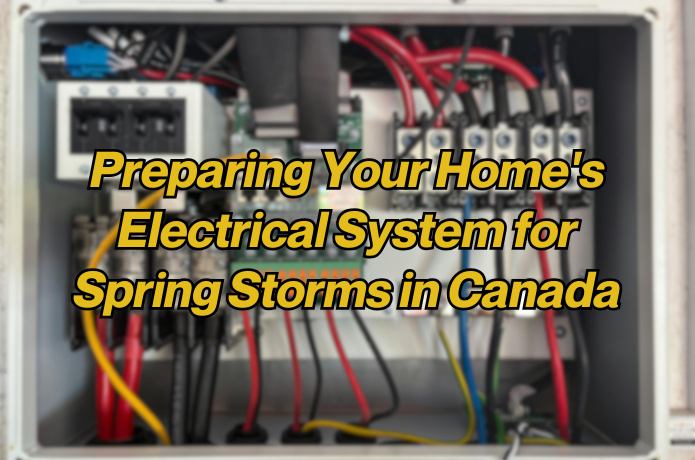Preparing Your Home's Electrical System for Spring Storms in Canada
Preparing Your Home's Electrical System for Spring Storms in Canada

Spring storms in Canada can bring unexpected weather, including heavy rains, strong winds, and even power outages. These storms may cause a significant strain on your home’s electrical system, which is why it’s important to prepare ahead of time. Ensuring your home’s electrical system is ready for the unpredictable nature of spring storms can help keep your home safe and reduce the risk of damage. In this article, we will explore the essential steps to take in order to prepare your home’s electrical system for spring storms, minimizing the chances of electrical failures and maximizing safety for your family.
Spring storms in Canada can lead to power outages, which can disrupt daily activities and cause damage to your home. These storms often bring lightning strikes, fallen trees, or strong winds that can affect power lines and electrical systems. By taking preventive measures now, you can reduce the risks associated with these weather events. It is crucial to focus on both preparing your electrical system to withstand storms and ensuring that it is in good working order before the storm season arrives. Here are some important steps to consider in getting your home’s electrical system ready for spring storms.
1. Inspect and Maintain Your Electrical Panel
One of the first things to check is your electrical panel. This panel controls the power supply to various parts of your home, and it needs to be in top condition. An electrical panel that is outdated or damaged can be a major hazard during storms. Make sure the panel is easily accessible and free of clutter. Additionally, check that the main circuit breaker is functioning properly, and if you notice any damage or signs of wear, it may be time for an upgrade. If you are unsure about the condition of your electrical panel, call a licensed electrician to inspect it. Regular maintenance of your electrical panel will ensure that it can handle fluctuations in power during storms.
2. Secure Outdoor Electrical Equipment
Outdoor electrical equipment, such as electrical outlets, wiring, and lights, should be properly secured before a spring storm hits. Strong winds and rain can cause outdoor wiring to become exposed or disconnected, posing a risk of electrocution or fire. Make sure that all outdoor electrical connections are tightly secured, and check that outdoor outlets have weatherproof covers. If possible, unplug outdoor electrical equipment, like garden lights or power tools, to avoid potential damage. Additionally, trim any nearby trees or branches that could potentially fall on power lines or electrical equipment during a storm. These precautions can help prevent electrical hazards outside your home.
3. Install a Surge Protector
A surge protector is a valuable tool for protecting your home’s electrical system during a storm. Lightning strikes, although rare, can cause power surges that can damage sensitive electronic devices and appliances. Installing surge protectors for your major appliances, such as your refrigerator, computer, or TV, can help protect these items from damage caused by power surges. Consider purchasing a whole-house surge protector, which will protect your entire electrical system from fluctuations in voltage. Having this protection in place will reduce the likelihood of your electronics being harmed by a sudden surge in power during a storm.
4. Check Your Home’s Wiring and Outlets
Old or faulty wiring is one of the main causes of electrical fires, and spring storms can exacerbate this risk. Check all visible wiring around your home for signs of wear or damage, such as frayed wires or exposed electrical cords. If you notice any issues, have an electrician repair or replace the wiring before storm season begins. Ensure that all outlets are functioning properly, and replace any that show signs of damage. Properly functioning outlets are essential for keeping your home’s electrical system safe during power outages and storms.
5. Test and Maintain Your Backup Power Source
If you live in an area prone to frequent power outages, having a backup power source, such as a generator, can be crucial. Generators can provide electricity to keep essential appliances running, like your refrigerator, lighting, and medical equipment. Before spring storm season begins, test your backup generator to ensure that it is functioning properly. Check the fuel levels, make sure all connections are secure, and perform any necessary maintenance. Having a reliable backup power source will give you peace of mind during a storm, knowing that you can maintain access to power even when the main electrical supply is interrupted.
6. Consider Installing a Lightning Rod
While not all homes need a lightning rod, it may be a good investment if your home is in an area where lightning strikes are common during spring storms. A lightning rod helps protect your home by providing a safe path for lightning to travel through, directing it away from your home’s electrical system. Installing a lightning rod is a relatively simple procedure that can save you from potential electrical damage caused by direct lightning strikes. Consult with a professional to determine whether a lightning rod is suitable for your home and location.
7. Prepare for Power Outages
Finally, it's essential to be prepared for the possibility of a power outage during spring storms. Keep an emergency kit that includes flashlights, batteries, a battery-operated radio, and other essentials. Having a stock of non-perishable food, water, and a portable charger for your mobile devices can also help you get through a power outage. If you have a backup generator, make sure it’s fully stocked with fuel and ready to use when necessary. Preparation is key to ensuring that you can stay safe and comfortable in case the power goes out during a spring storm.
Preparing your home’s electrical system for spring storms in Canada is essential for reducing the risk of damage and ensuring the safety of your home and family. From inspecting your electrical panel to securing outdoor equipment, there are several steps you can take to protect your electrical system from the unpredictable weather that often comes with spring storms. By taking proactive measures like installing surge protectors, maintaining your backup power source, and checking your home’s wiring, you can be better prepared for whatever the storm season brings. Storm preparedness not only protects your home but also ensures the safety and comfort of everyone who lives there.

